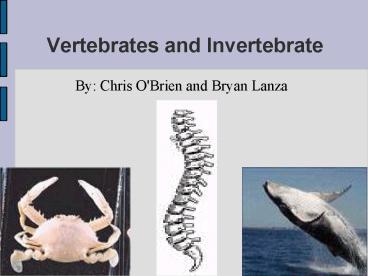Vertebrates and Invertebrate - PowerPoint PPT Presentation
1 / 12
Title:
Vertebrates and Invertebrate
Description:
Cold-blooded-body changes with environment. Skin can absorb waster and oxygen ... Largest change in life cycle of all classes (metamorphosis) Fish. Fresh or salt water ... – PowerPoint PPT presentation
Number of Views:83
Avg rating:3.0/5.0
Title: Vertebrates and Invertebrate
1
Vertebrates and Invertebrate
- By Chris O'Brien and Bryan Lanza
2
Vertebrates
- Mammals
- Reptile
- Amphibian
- Bird
- Fish
3
Mammals
- Make milk for young
- Fur or hair
- Get oxygen with lungs
- Warm-blooded-keep body temperature almost same at
all times - Develop in mom's body
- Babies look like parents
4
Reptiles- are similar to mammals
- Cold blooded-body changes with temperature
- Tough dry skin with scales
- Lay eggs
5
Amphibians
- Cold-blooded-body changes with environment
- Skin can absorb waster and oxygen
- Soft and moist skin
- Largest change in life cycle of all classes
(metamorphosis)
6
Fish
- Fresh or salt water
- Get oxygen through gills
- Scales/fins
- Life cycle like reptiles
- Lay eggs
7
Birds
- Warm-blooded
- Feathers
- Beaks
- Lay eggs
- Some fly
- Young need to be fed by parents
8
Invertebrate
- Mollusks
- Worms
- Arthropods
- Cnidarians
9
Mollusks
- Soft body without bones
- Hard outer shell (protects from being eaten)?
- Oxygen from gills
- Others get oxygen from water they absorb
10
Worms
- Live in wet or damp places
- Different sizes
- Longest worm is 7 meters (23feet) long
- Belong to many different phylum's
11
Arthropods
- Largest phylum of animals
- Arthropod means jointed feet
- Arthropods are insects
- Get oxygen in many different ways
- They have bodies divided into separate parts
12
Closing































